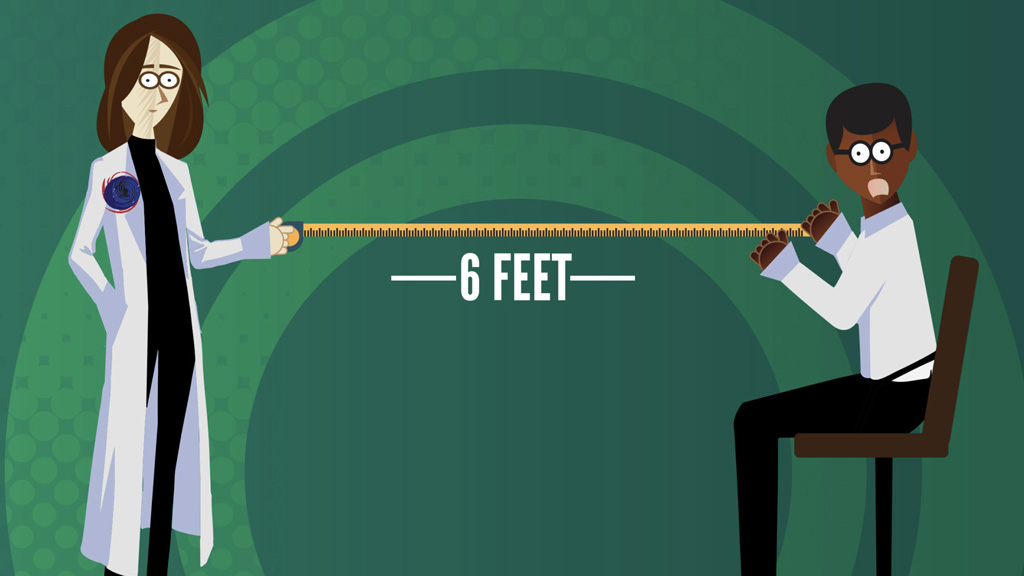As far as COVID-19 goes, Level 1 is the worst threat level. Harris County remains at Level 1, or “Severe Threat” for infection of the novel coronavirus. Yet, as they say in the theater, “The show must go on!” And for the most part, research is continuing in many ways. Surveys, interviews and other socially-distanced research has been easy to keep up during the COVID crisis.
How far away is six feet?
Some research must be done in person, though. Try to picture two golden retrievers standing nose to tail. Or a regular mattress. Or even the width of the front of your car. All of these measure in at about six feet. The droplets in the air are what can get you sick and when you stand at least six feet away from a person who is talking, laughing or coughing, you have a better chance of not breathing those virus molecules.
In the beginning…
In human subjects research, the safety of participant volunteers is always of the utmost importance. This has only become more critical with the entrance of the pandemic in March 2020, and remains so today. In early March, PIs at the University of Houston were asked to review each of their studies and to let the University know whether missing visits would be detrimental to the safety or well-being of human subjects.
Some clinical studies (specifically those taking part in clinics that provide paid health services) were often allowed to continue under COVID precautions adopted by the medical community. Just as if you went to a doctor’s office, there were rules: the 6-foot apart rule, mandatory mask-wearing, extra disinfecting and temperature checks. In some cases, modifications made such as the addition of plexiglass to instrumentation increased the safety of research procedures. Additional protections are in place to protect research staff and students; student involvement in research remains strictly voluntary.
What about IRBs?
At the University of Houston (UH), the Research Integrity and Oversight office is working with groups of faculty investigators, general counsel, Environmental Health and Safety and Emergency Management to put in place safety precautions for re-starting human subjects research where subjects are within six feet of the research team. This will happen once Judge Lina Hidalgo determines that Harris County may be downgraded to Level 2. These institutional requirements are in addition to and on top of the normal precautions taken by the Institutional Review Board, which is formally designated to, among other tasks, review, approve, require modifications in (to secure approval), or disapprove all research activities involving human subjects.
Up close and personal
In the instance Harris County is downgraded to Threat Level 2, COVID-19 procedures have been approved for subjects undergoing research procedures at the UH College of Optometry and in Health and Human and Performance exercise physiology studies. Physiology test subjects are often on treadmills or are exhaling more droplets into the air through exertion brought on by exercise.
COVID-19 procedures for other research that include test subjects that need to be closer than six feet apart (examples: applying sensors, walking in an exoskeleton, completing manual tasks, etc.) have been submitted for review and are currently being evaluated. As this group encompasses such a wide variety of research procedures, it has taken the longest to draft.
Contact tracing
Screening questions, non-recorded temperature checks and a log of updated contact information are now required for all research endeavors. Screening questions mirror those recommended by CDC, including attestations as to whether the participant has had symptoms, travelled out of the country, or has been in contact with anyone who has tested positive for COVID.
The contact information is so that correct information is available should the researcher be contacted by a city or county health department for contact tracing purposes if a positive test result is reported for a subject or research team member. Finally, all subjects are asked to read and sign a document (in addition to the consent form) that explains the increased protections the university has put in place for those coming to campus during the pandemic, including face coverings, social distancing when possible and additional protections depending on the type of research being conducted.
Exceptions
Kirstin Holzschuh, executive director of UH’s Research Integrity and Oversight office said, “If there is a compelling justification – for example, a PI is conducting a long-term longitudinal study and missing data points might invalidate the study, or we are one of many research sites and are in jeopardy of losing funding because other (typically non-academic) sites are enrolling and we are not – the PI can contact the Research Integrity and Oversight office and request to use the procedures approved for Level 2 under Threat Level 1.” But this also goes through a review process and requires a signed agreement by the investigator that they will follow all approved COVID procedures.
Always safety first!
There are always risks and benefits to participating in research, but what must be kept at the foreground of one’s human subjects research is that we are considering volunteers. Research subjects must always weigh the risks and benefits of participating in research; a researcher must provide these risks and benefits in clear language that allows the subject to make an informed decision.
“During times of increased risk, such as a pandemic, the university must take further precautions to protect and inform our research subjects regarding the risks of being on campus during a pandemic. Research subjects and their commitment to the greater good fuel our research enterprise, and their safety is always paramount,” said Holzschuh.



